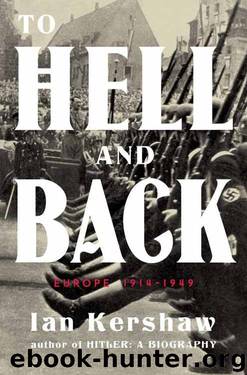To Hell and Back: Europe 1914-1949 (Penguin History of Europe (Viking)) by Ian Kershaw

Author:Ian Kershaw [Kershaw, Ian]
Language: eng
Format: epub, mobi
Publisher: Penguin Publishing Group
Published: 2015-11-17T08:00:00+00:00
DYNAMIC DICTATORSHIPS IN COMPARISON
The three dynamic dictatorships – Stalin’s Soviet Union, Mussolini’s Italy and Hitler’s Germany – were in practice quite distinctive forms of rule even though they had a number of structural features in common. Stalin’s regime stands out plainly from the other two, which share more similar characteristics (and some ‘borrowings’ by Nazi Germany from Fascist Italy) though also displaying crucial differences. Each made a ‘total claim’ on its citizens. This was not realized in practice and most weakly accomplished in Fascist Italy – paradoxically the only one of the three regimes explicitly to declare that it was building a ‘totalitarian state’. However, the ‘total claim’ unquestionably had huge consequences for the behaviour of citizens in such heavily orchestrated and controlled societies. ‘Political space’ and forms of organized social activity, even compared with those in other dictatorships of the era let alone liberal democracies, effectively ceased to exist outside what was permitted and managed by the regime itself. A ceaseless attempt was made in each of the three regimes to mould attitudes and behaviour according to exclusive ideological tenets. Identity with the regime was underpinned and reinforced through emphasis on the ‘enemy within’ – the ‘outsiders’ whose very existence shaped the creation of a community of ‘insiders’, of those who ‘belonged’.
The penetration of society by regime values was lowest in Italy, in all probability greatest in Germany. The success of indoctrination was variable, though most apparent in all three regimes among the young. In each instance, the regime had substantial success in mobilizing large numbers of idealists and gaining extensive popular support. Quantifying the support is impossible, given the repression of all opposition on which each regime rested and the lack of freedom of expression. From the imprecise indicators available, Nazi Germany had the greatest level of popular support, Italy was some distance behind, while the Soviet Union was the most coerced population, suggestive of the least authentic support.
Each deployed the heavy hand of terroristic repression. For those terrorized by the police state, the ideological or structural differences between the regimes were a matter of the purest indifference. Even so, they mattered. The Soviet Union exerted an extraordinary level of terror directed at its own citizens, far more than the other two regimes, an arbitrary, unpredictable deterrence not replicated elsewhere. Nazi terror focused on quashing organized political opposition then, increasingly, on weak and small minorities – Jews, especially, and other racial or social ‘outsider’ groups. The worst of Fascist terror was reserved for Italy’s African colonies. At home, once the early street violence of castor oil and the cudgel had waned, the application of terror was mild in comparison with that of the other two regimes, concentrating on eliminating known opponents but otherwise largely content with a strategy of containment.
Where Fascist Italy was also weakest was in its ideological dynamism and its militarization. Much of the mobilization of society was little more than superficial. After more than a decade of Fascist rule, the gap between rhetoric and reality was sizeable.
Download
To Hell and Back: Europe 1914-1949 (Penguin History of Europe (Viking)) by Ian Kershaw.mobi
This site does not store any files on its server. We only index and link to content provided by other sites. Please contact the content providers to delete copyright contents if any and email us, we'll remove relevant links or contents immediately.
| Africa | Americas |
| Arctic & Antarctica | Asia |
| Australia & Oceania | Europe |
| Middle East | Russia |
| United States | World |
| Ancient Civilizations | Military |
| Historical Study & Educational Resources |
Room 212 by Kate Stewart(4742)
The Crown by Robert Lacey(4578)
Endurance: Shackleton's Incredible Voyage by Alfred Lansing(4517)
The Iron Duke by The Iron Duke(4126)
The Rape of Nanking by Iris Chang(4025)
Killing England by Bill O'Reilly(3901)
Joan of Arc by Mary Gordon(3794)
Say Nothing by Patrick Radden Keefe(3731)
I'll Give You the Sun by Jandy Nelson(3275)
Shadow of Night by Deborah Harkness(3182)
Hitler's Monsters by Eric Kurlander(3171)
Mary, Queen of Scots, and the Murder of Lord Darnley by Alison Weir(3073)
Blood and Sand by Alex Von Tunzelmann(3060)
Darkest Hour by Anthony McCarten(3019)
Margaret Thatcher: The Autobiography by Thatcher Margaret(2973)
Eleanor & Park by Rainbow Rowell(2947)
Red Famine: Stalin's War on Ukraine by Anne Applebaum(2817)
Book of Life by Deborah Harkness(2726)
The One Memory of Flora Banks by Emily Barr(2687)
